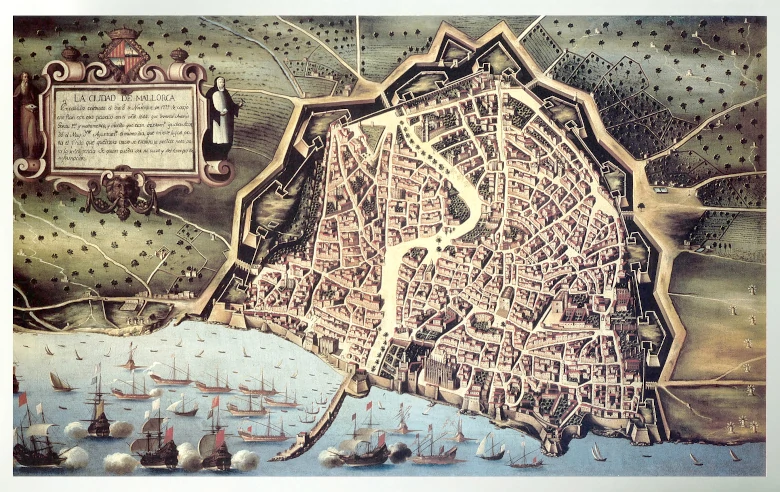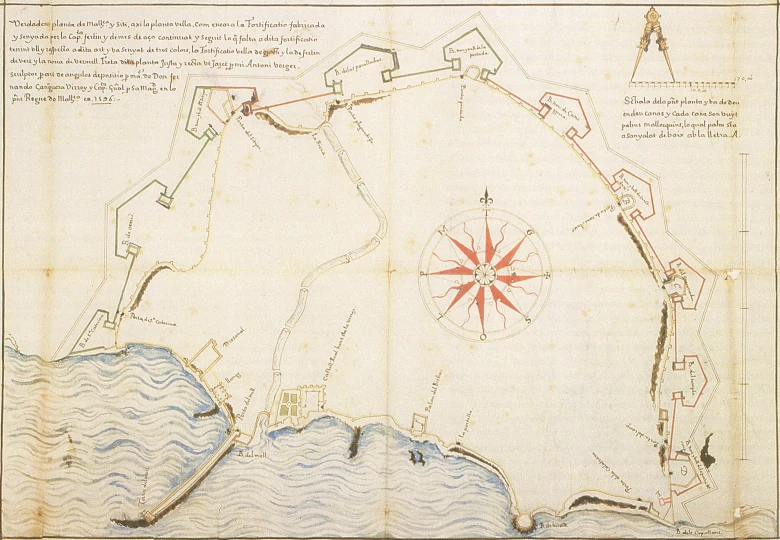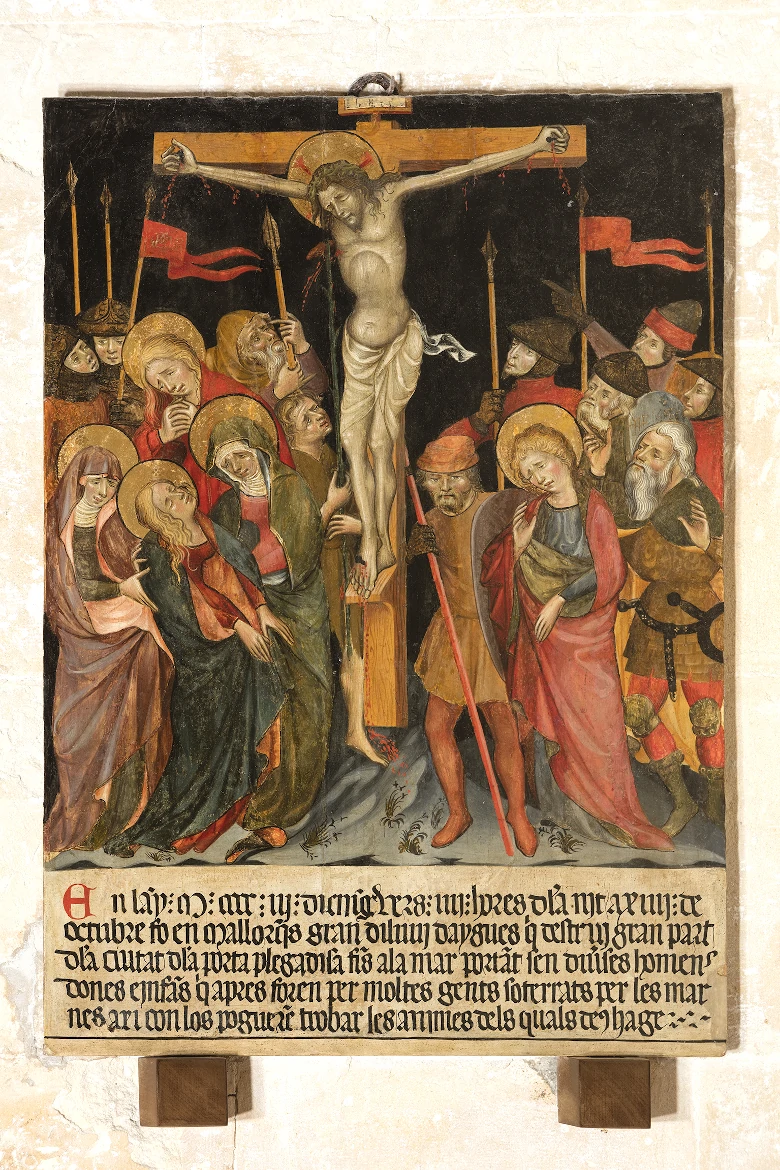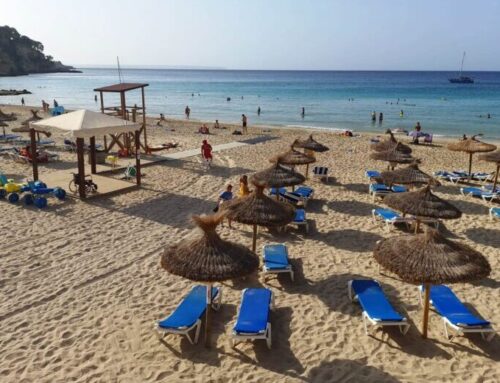
There are several torrents that flow through the municipality of Palma. The Riera stream is one of the most important. It rises in Puigpunyent and runs for some 24 kilometres. Its main course is fed by multiple tributaries which, when added together, describe a basin one hundred and forty-three kilometres long. Due to its morphology, during heavy rainfall, the torrent, in a short time, collects large quantities of water, which causes the current to descend with great force.

Anonymous map of Palma, made around 1647, showing how the old course of the Riera has been converted into the Rambla and Borne promenades.
In the past, the stream flowed into a steep gorge on its east bank, while the west bank was not very uneven, rather flat. When the Romans founded the city of Palma, they took the precaution of settling on the high part of this ravine, safe from possible overflows and floods. But when the city was renamed Madina Mayurqa in the Muslim period, it expanded considerably, and thus occupied the other bank, which was flatter. In this way a city was formed with an upper and a lower area, and the riverbed of the torrent became the border between the two, with a network of bridges connecting the two. In the 11th century, when the Muslims decided to build a new wall covering the whole of Madina Mayurqa, the last section of the Riera was left inside the enclosure. It penetrated the wall through an arch. The keystone that closed this arch had an Arabic inscription which, in the time of Pedro de Alcántara Peña, was preserved embedded in one of the walls of the hallway of the Palma Town Hall.
1403 was the year of the great calamity, el año de lo diluvi, as the documents of the time call it
The torrent must have caused significant flooding over the following centuries. In fact, when Madina Mayurqa had already become the City of Mallorca, in 1303, the King of Mallorca, James II, commissioned the governor Dalmau de Garriga with a project to divert its course in order to prevent it from entering the city and thus prevent flooding. Without knowing the causes, the king’s project could not be carried out. No one suspected at that time that, just one hundred years later, a catastrophe of unimaginable dimensions would take place in Palma.

Map by Antoni Verger from 1596, showing the old course of the Riera when it crossed the interior of Palma, separating the upper and lower areas of the city. The bridges are also drawn.
1403 was the year of the great calamity, the year of the deluge, as the documents of the time call it. On Friday 12 October, it began to rain all day long, non-stop, and it rained heavily – great floods took place, as the notary Mateu Salzet, an eyewitness to that deluge, wrote in his writings. It continued to rain all night and all day Saturday, until the early hours of Sunday morning. During these two days, the water flowed down the Riera from Puigpunyent with unusual force. When the water reached the city, it passed under the arch in the wall, which for months had been obstructed by wooden sticks that had been placed by the buyers of the wine and milling armoury to prevent the smuggling of wine and flour. This meant that the hole under the arch was quickly clogged by a jumble of branches, trees and mud that was violently dragged along by the current.
In addition, the wall, at this point, due to the shape of the bowl that described the stream bed, followed a semicircular shape, forming an amphitheatre on its outer face, so that a huge volume of water was deposited there. In this way, an improvised lake grew and soon spilled over the walls of the numerous orchards outside the walls, knocking them down and adding more mud to the raging mire that was constantly battering the walls of the city. The level of the accumulated water soon reached the top of the city walls and even exceeded them by more than three metres. The high walls of the ancient Madina Mayurqa held for two days, but at five o’clock on Sunday morning, they gave way, collapsed and were swept away by a powerful, raging wave that destroyed everything in its path until it was relieved in the wide sea.

Gothic tablet dedicated to the victims of the flood of 1403, preserved in the Cathedral:En lo any de M CCCC III, dicmenge, vers 4 hores de la nit a 14 de octubre fo en Mallorques gran diluvi d’aygues que destruí gran part de la Ciutat de la Porta Plegadisa fins a la mar portant sen diverses homens dones e infans qui aprés foren per moltes gents soterrats per les marines axí con los pogueren trobar les ànimes dels quals Deus hage.
It is very difficult to get an accurate picture of the volume of water that entered the city. In the Market Square, the water level reached a height of almost eight metres, and more than three metres at the top of Santacilia Street. Most of the houses and orchards that flanked the torrent, being built from the foundations upwards, collapsed one after the other. The catastrophe took a Dantesque, apocalyptic turn. More than five thousand people died, fifteen hundred buildings simply disappeared and another five hundred had to be shored up. The bay of Palma became a scene of death and desolation. The water turned brown and furniture and corpses floated in it. As the easterly wind blew, the bodies were dragged to Illetas. Many of them were buried there. In 1406, most of them were exhumed and taken to the Cathedral, where they received their final burial, and that same year two altarpieces were painted in memory of all the victims.








Leave A Comment